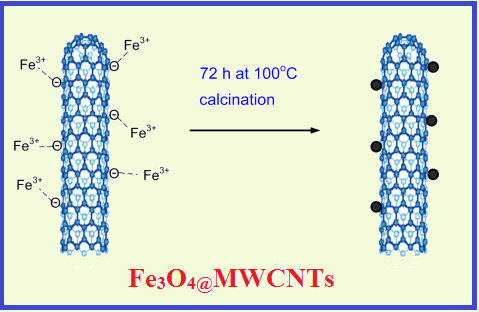Removal of Metronidazole residues from aqueous solutions based on magnetic multiwalled carbon nanotubes by response surface methodology and isotherm study
Volume 3, Issue 03, Pages 44-53, Sep 2020 *** Field: Environmental Analytical Chemistry
Abstract
Antibiotics and pharmaceutical products cannot remove by conventional sewage treatment. In this work, an effective adsorbent magnetic multiwalled carbon nanotube (Fe3O4@MWCNTs) was synthesized by co-precipitation of MWCNTs with Fe3O4 and used for removal of Metronidazole from aqueous solutions. Response surface methodology on central composition design (CCD) was applied for designing of experiments and building of models for Metronidazole removal before a determination by HPLC. Four factors including pH, the adsorbent dose, time, and temperature were studied and used for the quadratic equation model to the prediction of optimal points. By solvent the equation and considering the regression coefficient (R2 =0.9997), the optimal points obtained as follows: pH =2.98; adsorbent dosage =2.16 g; time =22 min and temperature = 37.9 o C. The isotherm study of adsorption showed that the metronidazole adsorption on Fe3O4@MWCNTs follows the Langmuir model. The maximum adsorption capacity (AC) is 215 mg g-1 obtained from Langmuir isotherm.
References
W.Yan, Y. Xiao, W. Yan, The effect of bioelectrochemical systems on antibiotics removal and antibiotic resistance genes: a review, Chem. Eng. J. 358 (2019) 1421-1437.
J. Xu, Z. Cao, Y. Wang, Y. Zhang, X. Gao, Distributing sulfidized nanoscale zerovalent iron onto phosphorus-functionalized biochar for enhanced removal of antibiotic florfenicol, Chem. Eng. J., 359 (2019) 713-722.
T. D. Pham, T. Ngan Vu, H. L. Nguyen, Adsorptive removal of antibiotic ciprofloxacin from aqueous solution using protein-modified nanosilica, Polymers, 12 (2020) 57.
N. Hanna, P. Sun, Q. Sun, Presence of antibiotic residues in various environmental compartments of Shandong province in eastern China: its potential for resistance development and ecological and human risk, Environ. Int., 114 (2018) 131-142.
R. Pallares-Vega, Determinants of presence and removal of antibiotic resistance genes during WWTP treatment: a cross-sectional study, Water Res., 161 (2019) 319-328.
T. Ariyanto, R. Aprillia G. Sarwendah, Y. Maulana, Modifying nanoporous carbon through hydrogen peroxide oxidation for removal of metronidazole antibiotics from simulated wastewater, Processes, 7 (2019) 835.
M. L. Tran, C.-C. Fu, R.-S. Juang, Removal of metronidazole and amoxicillin mixtures by UV/TiO 2 photocatalysis: an insight into degradation pathways and performance improvement, Environ. Sci. Pollut. Res., 26 (2019) 11846-11855.
Y. Zhou, T. Wang, D. Zhi, Applications of nanoscale zero-valent iron and its composites to the removal of antibiotics: a review, J. Mater. Sci., (2019) 1-18.
Zhang, Shuai, et al. "A review of bioelectrochemical systems for antibiotic removal: Efficient antibiotic removal and dissemination of antibiotic resistance genes, J. Water Process Eng., 37 (2020) 101421.
S.Talwar, A. K. Verma, V. K. Sangal, U. L. Štangar, Once through continuous flow removal of metronidazole by dual effect of photo-Fenton and photocatalysis in a compound parabolic concentrator at pilot plant scale, Chem. Eng. J. 388 (2020) 124184.
B. Davoud, A. Dokht Khatibi, K. Chandrika, Antibiotics removal from aqueous Solution and pharmaceutical wastewater by adsorption process: A review, Int. J. Pharm. Investigate., 10 (2020) 106-111.
H. Cai, T. Zhao, Z. Ma, J. Liu, Efficient Removal of Metronidazole by the Photo-Fenton Process with a Magnetic Fe3O4@ PBC Composite, J. Environ. Eng., 146 (2020) 04020056.
• [13] K. Hasani, A. Peyghami, A. Moharrami, The efficacy of sono-electro-Fenton process for removal of Cefixime antibiotic from aqueous solutions by response surface methodology (RSM) and evaluation of toxicity of effluent by microorganisms, Arab. J. Chem. 13 (2020) 6122-6139.
M. Galedari, M. Mehdipour Ghazi, S. R. Mirmasoomi, Photocatalytic process for the tetracycline removal under visible light: Presenting a degradation model and optimization using response surface methodology (RSM), Chem. Eng. Res. Design, 145 (2019) 323-333.
S. Gholamiyan, M. Hamzehloo, F. Abdolhadi, RSM optimized adsorptive removal of erythromycin using magnetic activated carbon: Adsorption isotherm, kinetic modeling and thermodynamic studies, Sustain. Chem. Pharm., 17 (2020) 100309.

Copyright (c) 2020 Analytical Methods in Environmental Chemistry Journal

This work is licensed under a Creative Commons Attribution 4.0 International License.
JOURNAL PUBLISHING AGREEMENT
PLEASE PROVIDE US THE FOLLOWING INFORMATION,
Article entitled:
Corresponding author:
To be published in the journal:
Your Status
I am the sole author of the manuscript
- I am an Iranian government employee.
- I am a European government employee
- I am a Asian government
- None of the above
I am one author signing on behalf of all co-authors of the manuscript
- I am an Iranian government employee.
- I am a European government employee
- I am a Asian government
- None of the above
Please tick the above blanks (as appropriate), review the Journal Publishing Agreement, and then sign and date the document in black ink.
Published Journal Article: the author may share a link to the formal publication through the relevant DOI. Additionally theses and dissertations which contain embedded Published Journal Articles as part of the formal submission may be hosted publicly by the awarding institution with a link to the formal publication through the relevant DOI. Any other sharing of Published Journal Articles is by agreement with the publisher only.
Signed: ______________________________________ Name printed: ___________________________________________
Title and Company (if employer representative): _______________________Date: __________________________________














